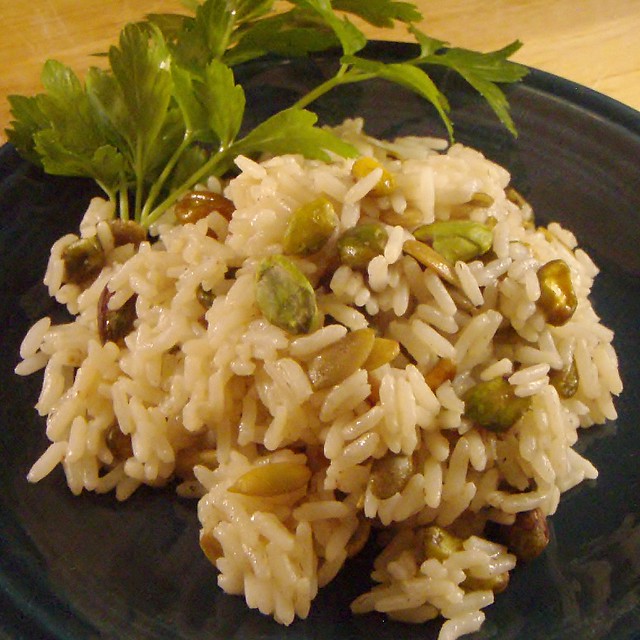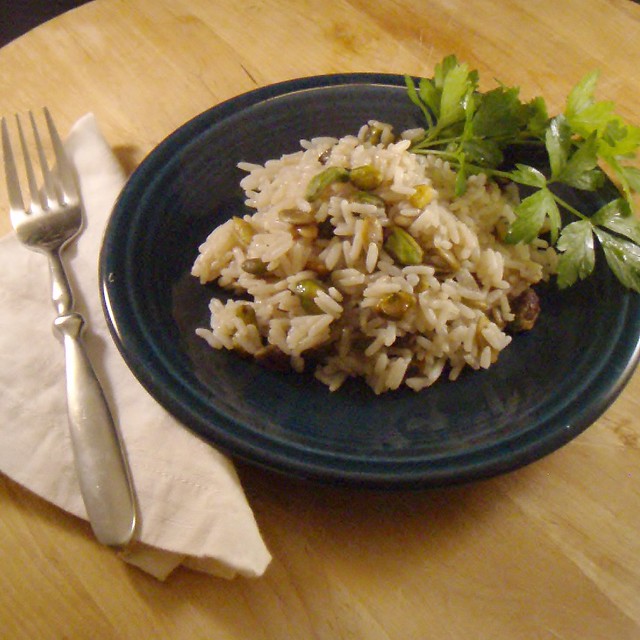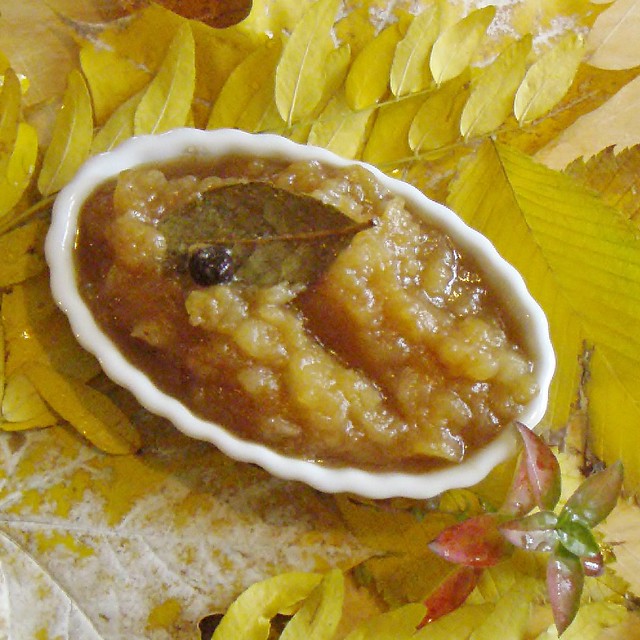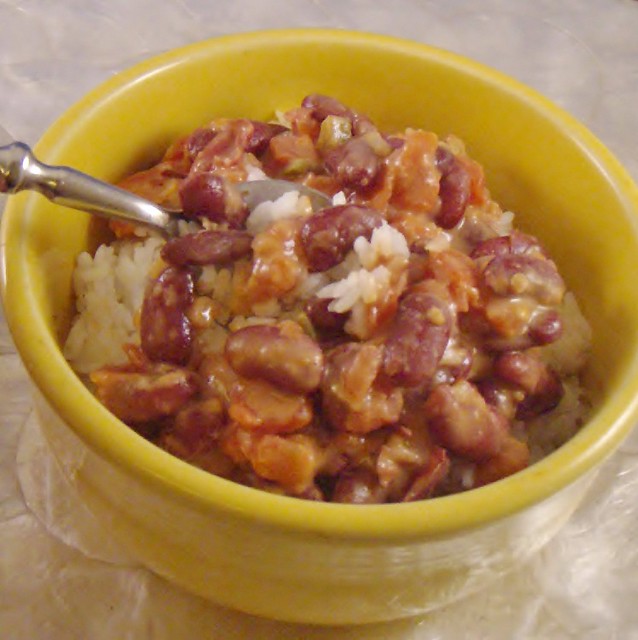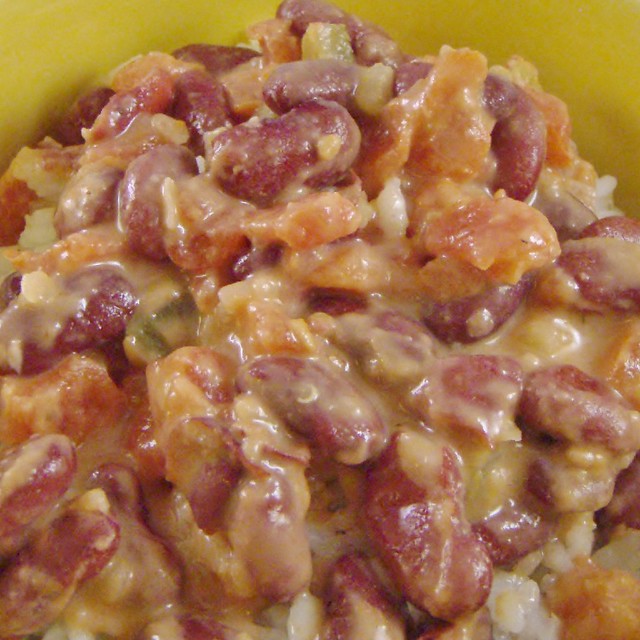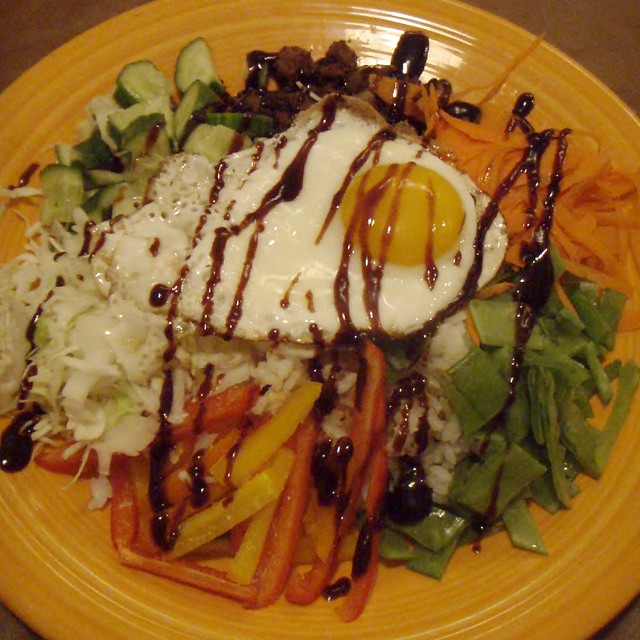The American Dental Association and their new website,
stopzombiemouth.com (definitely worth a visit, especially if you have kids) bring us this infographic about Halloween.Wednesday, October 31, 2012
Policy Point Wednesday: Happy Halloween!
Wednesday, October 24, 2012
The Food Desert Project: Thomas Jefferson's Perloo
Pilau, or Perloo (for those of you who love Pogo like we do,) is an American Lowcountry rice dish based loosely on the rice pilafs and biryanis of the middle east and India. I don't know if you are aware of the adventurous kitchen of founding father Thomas Jefferson, but he was about as experimental a gourmet as was possible before air travel. This simple dish is purported to be one of his favorites, mostly because the original used both pignoli and pistachios, exotic nuts just being introduced into Europe via Italy. The Glory of Southern Cooking reports that Jefferson most likely brought back both kinds of trees to cultivate at Monticello, and he might well be responsible for bringing in the cultivars we use in the US today. (Jefferson's garden had an unbelievable impact on American horticulture and agriculture.)
This is one of those simple dishes that packs a lot of flavor into a small, plain package: I can't wait to see how it goes with the turkey I'm planning to roast tonight! If your food desert doesn't offer unsalted raw nuts, give them a quick soak in warm water and then rinse and drain them before toasting; you may want to eliminate the salt entirely. You may not be able to find pignoli and they are expensive no matter where you find them, so I substituted pepitas, or roasted pumpkin seeds. If you can't find those, use sunflower seeds.
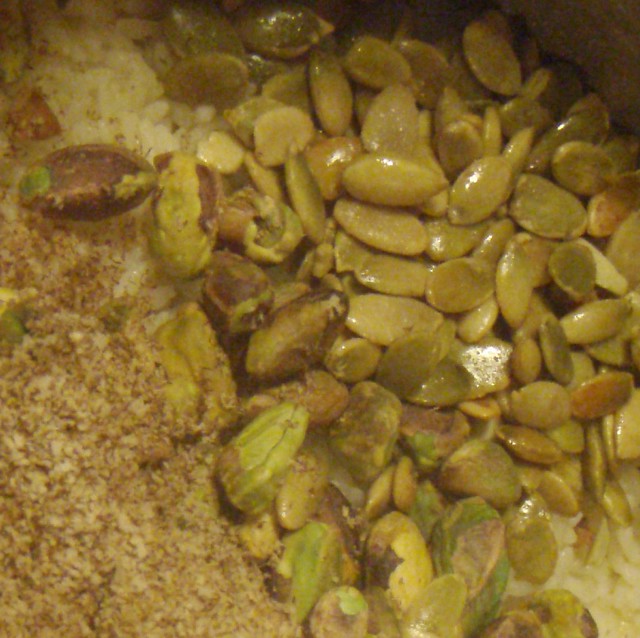 2 cups low-sodium chicken stock
2 cups low-sodium chicken stock
2 tbsp butter
1 cup long-grain or converted rice
1/2 cup pistachios
1/4 cup pepitas or pignoli
1 tsp salt (or salt to taste if using rinsed salted nuts)
1/4 tsp nutmeg
Put the butter, stock and rice in a pot and bring to a boil. Cover and turn the heat to low for about 20-25 minutes, or until all the liquid is absorbed. In the meantime, toast the nuts lightly in a skillet until they are fragrant. When the rice is done, mix in the nutmeg and nuts and season with salt. Enjoy!
I can't think of Perloo without thinking of Walt Kelly's Pogo cartoons of the 1960s. We are blessed to have inherited a neighbor's collection of Pogo comic books, and in one, Equal Time for Pogo, there is an entire strip dedicated to the 1968 Republican candidates for President...including George W. Romney and Ronald Reagan. I remember first coming across this strip during the Reagan era, and now, here it is again...the timelessness of these pieces is amazing!
Just a little reminder for all our US readers: history is watching us! Get out there and exercise your right to cast an educated vote for the candidates and issues of your choosing! (P.S. For extra bonus points, I heard a rumor that early voters are removed from political phone-call lists! Yippee!)
This is one of those simple dishes that packs a lot of flavor into a small, plain package: I can't wait to see how it goes with the turkey I'm planning to roast tonight! If your food desert doesn't offer unsalted raw nuts, give them a quick soak in warm water and then rinse and drain them before toasting; you may want to eliminate the salt entirely. You may not be able to find pignoli and they are expensive no matter where you find them, so I substituted pepitas, or roasted pumpkin seeds. If you can't find those, use sunflower seeds.
 2 cups low-sodium chicken stock
2 cups low-sodium chicken stock2 tbsp butter
1 cup long-grain or converted rice
1/2 cup pistachios
1/4 cup pepitas or pignoli
1 tsp salt (or salt to taste if using rinsed salted nuts)
1/4 tsp nutmeg
Put the butter, stock and rice in a pot and bring to a boil. Cover and turn the heat to low for about 20-25 minutes, or until all the liquid is absorbed. In the meantime, toast the nuts lightly in a skillet until they are fragrant. When the rice is done, mix in the nutmeg and nuts and season with salt. Enjoy!
I can't think of Perloo without thinking of Walt Kelly's Pogo cartoons of the 1960s. We are blessed to have inherited a neighbor's collection of Pogo comic books, and in one, Equal Time for Pogo, there is an entire strip dedicated to the 1968 Republican candidates for President...including George W. Romney and Ronald Reagan. I remember first coming across this strip during the Reagan era, and now, here it is again...the timelessness of these pieces is amazing!
Just a little reminder for all our US readers: history is watching us! Get out there and exercise your right to cast an educated vote for the candidates and issues of your choosing! (P.S. For extra bonus points, I heard a rumor that early voters are removed from political phone-call lists! Yippee!)
Sunday, October 21, 2012
Sundays with Sparky: Save the Apples! Spiced Applesauce
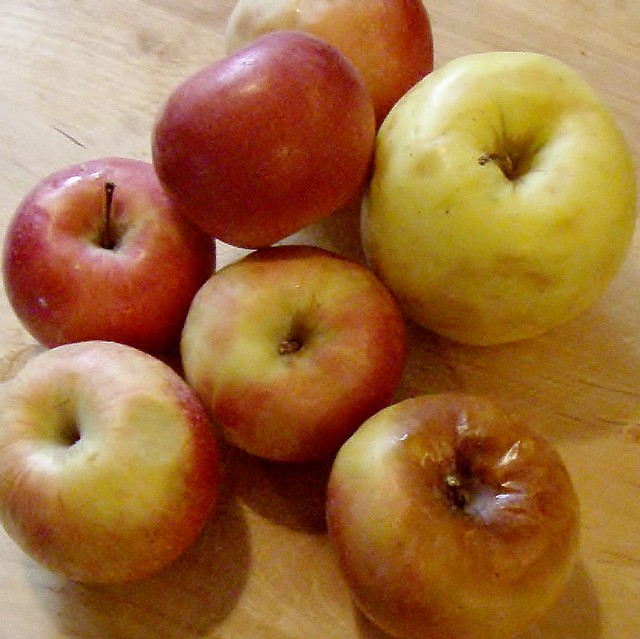 Keeping ahead of your produce can be a full-time job. It's often cheaper to buy food in bulk, but since Sparky is one of those kids who refuses to eat apples that aren't perfect...a week or so after I've bought them, they wind up abandoned in the fruit bowl looking like this:
Keeping ahead of your produce can be a full-time job. It's often cheaper to buy food in bulk, but since Sparky is one of those kids who refuses to eat apples that aren't perfect...a week or so after I've bought them, they wind up abandoned in the fruit bowl looking like this:Fortunately for us, apples are cheap, and even those that have become unfashionably bumpy make terrific applesauce.
There are two schools of thought when it comes to homemade applesauce: the lazy school (my preference) which just cuts apples in half, cooks them until they fall apart, and strains the cooked apples to remove seeds and skins. In addition to being no-peel, this method takes advantage of the natural pectin in the skins and near the seeds, and makes a thick, silky applesauce. The second school of thought prefers velvety chunks in their applesauce. This requires peeling and coring the apples, cooking them in large pieces and letting them slowly fall apart naturally, and makes a juicy applesauce.
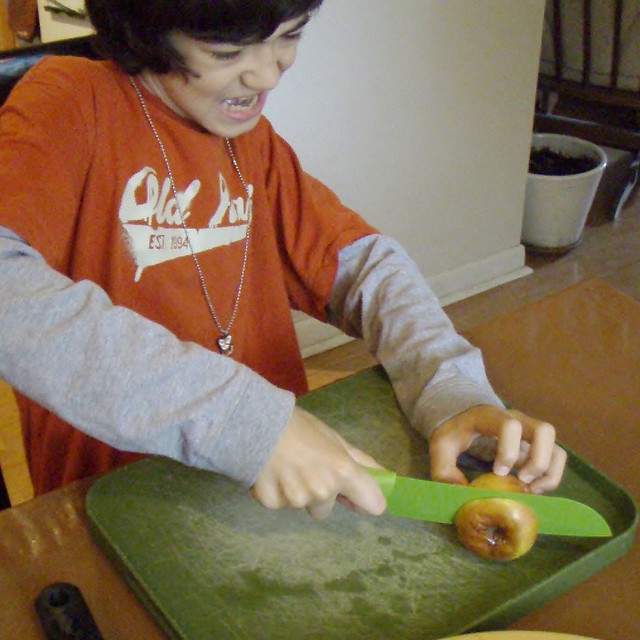 I decided to teach Sparky both methods simultaneously and get the best of both worlds, so after a Fruit-Ninja-style removal of the bad parts, he peeled and cored the apples
I decided to teach Sparky both methods simultaneously and get the best of both worlds, so after a Fruit-Ninja-style removal of the bad parts, he peeled and cored the apples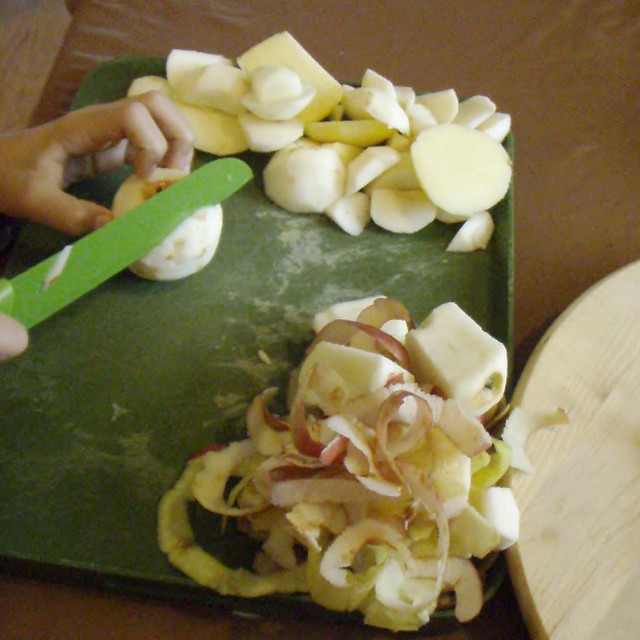 (my favorite coring method: cut the 4 faces off each apple and leave a small rectangle with the core in it.)
(my favorite coring method: cut the 4 faces off each apple and leave a small rectangle with the core in it.)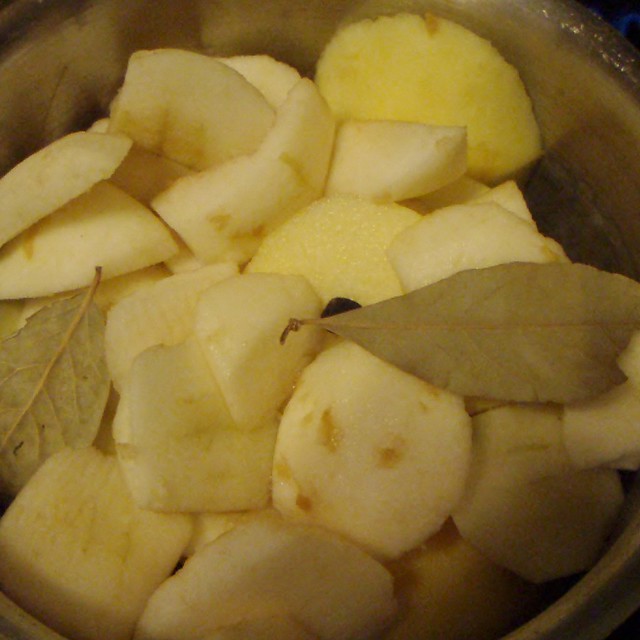 We put the cores and peels into one pot, and the peeled apple chunks into another along with a four allspice berries and a couple of bay leaves (Sparky adds cinnamon to taste when he eats it, you can also add a cinnamon stick during cooking.) We added a slosh of apple cider (water is fine) to each pot to keep the bottom from burning.
We put the cores and peels into one pot, and the peeled apple chunks into another along with a four allspice berries and a couple of bay leaves (Sparky adds cinnamon to taste when he eats it, you can also add a cinnamon stick during cooking.) We added a slosh of apple cider (water is fine) to each pot to keep the bottom from burning.Sparky turned the heat to high until the liquid was boiling, then covered the pots and reduced the heat to medium-low heat for a total of about 15 minutes, stirring every 5 minutes or so. The apple chunks released a lot of juice, so every so often we drained it into the pot with the cores and peels to help them cook faster.
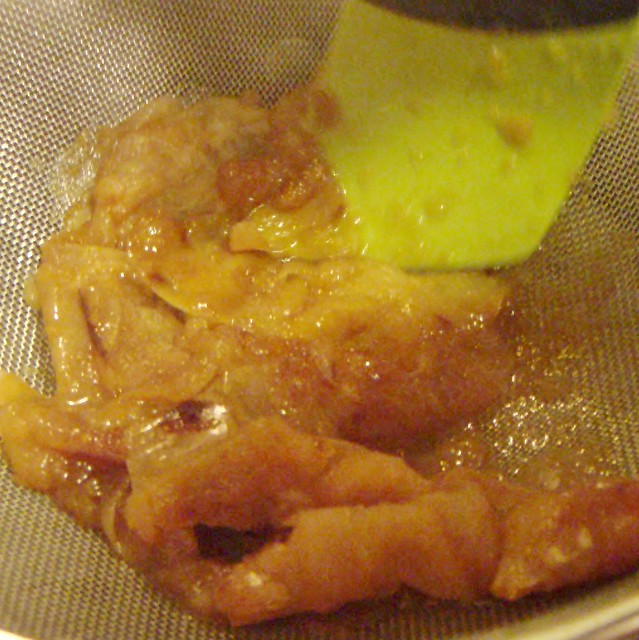 After the apple chunks were fork-tender, we increased the temperature of the cores and peels and allowed them to caramelize slightly (when you do this, you'll see how much better the juice thickens with cores and peels) and then we scraped them through a sieve directly into the pot of apple chunks, discarding the peels and seeds that were left behind.
After the apple chunks were fork-tender, we increased the temperature of the cores and peels and allowed them to caramelize slightly (when you do this, you'll see how much better the juice thickens with cores and peels) and then we scraped them through a sieve directly into the pot of apple chunks, discarding the peels and seeds that were left behind. Sparky then used a spatula to mix the two sauces together, lightly mashing the chunks as it bubbled together until we had a beautiful, silky, chunky applesauce. Mmmm.
Sparky then used a spatula to mix the two sauces together, lightly mashing the chunks as it bubbled together until we had a beautiful, silky, chunky applesauce. Mmmm.
Serve warm or cold, with cinnamon or without; I can't imagine autumn without it! Enjoy!
Wednesday, October 17, 2012
Policy Point Wednesday: Food Innovations
The Royal Society, an independent UK academy of science promoting the natural and applied sciences, recently published a list of the top 20 food innovations. Interestingly, the top three spots were reserved for modern methods of food preservation: refrigeration, pasteurization/ sterilization, and canning.
Reading the list made me realize how little thought even the food-obsessed like me give our food, as the large majority of these innovations are used before food even reaches the store. For instance, six of the innovations improve food production, e.g. the fishing net, crop rotation, the plow, irrigation, the threshing machine/combine harvester, and selective breeding/strains. Six others have to do with processing and large-capacity or long-term food storage (home canning does happen, it's rare these days) e.g. pasteurization/sterilization, canning, grinding/milling, fermentation, the cork and the barrel. These sometimes simple changes in how we approach our food are a defense against both starvation and food-borne illness.
Of the remaining nine items on the list: refrigeration, the oven, baking, the pot, the knife, eating utensils, the microwave oven and frying, we don't really think about them as a barrier to pathogens. If you think about it, most of the innovations keep food out of the "temperature danger zone," or otherwise act as a barrier to pathogens. Even a knife can be used to cut "bad" parts of food away, and to make food small enough to be cooked safely.
We tend to take all of these innovations for granted, but food production and food safety are a major factor in our current prosperity. In particular, Americans never think about cholera or typhoid - but these two diseases are still serious threats in areas where these kinds of technologies are limited. We've also conquered many of the vitamin deficiencies suffered by our forbears, due in part to these sometimes simple technologies for food production and storage.
Reading the list made me realize how little thought even the food-obsessed like me give our food, as the large majority of these innovations are used before food even reaches the store. For instance, six of the innovations improve food production, e.g. the fishing net, crop rotation, the plow, irrigation, the threshing machine/combine harvester, and selective breeding/strains. Six others have to do with processing and large-capacity or long-term food storage (home canning does happen, it's rare these days) e.g. pasteurization/sterilization, canning, grinding/milling, fermentation, the cork and the barrel. These sometimes simple changes in how we approach our food are a defense against both starvation and food-borne illness.
Of the remaining nine items on the list: refrigeration, the oven, baking, the pot, the knife, eating utensils, the microwave oven and frying, we don't really think about them as a barrier to pathogens. If you think about it, most of the innovations keep food out of the "temperature danger zone," or otherwise act as a barrier to pathogens. Even a knife can be used to cut "bad" parts of food away, and to make food small enough to be cooked safely.
We tend to take all of these innovations for granted, but food production and food safety are a major factor in our current prosperity. In particular, Americans never think about cholera or typhoid - but these two diseases are still serious threats in areas where these kinds of technologies are limited. We've also conquered many of the vitamin deficiencies suffered by our forbears, due in part to these sometimes simple technologies for food production and storage.
Wednesday, October 10, 2012
The Food Desert Project: Tanzanian Coconut Beans
Most often, when surfing the web for ideas, I suddenly find myself in an entirely different hemisphere. So many cultures depend on preserved foods! I'm not sure exactly how I stumbled across this charming website, but I can't wait to introduce you to Kulmansam. At his site you can learn about Tanzanian culture and food as well as a bit of kiSwahili. The following recipe is my food-desert version of his recipe for Maharage ya Nazi, or Tanzanian Coconut Beans.
I can attest to the fact that this is a really easy recipe. No - I mean REALLY easy. The reason I can attest to this is that I managed to get this dish on the table despite fingers with 2nd-degree burns, an infestation of pantry moths, a mouse who left a wake of devastation in my kitchen last night culminating in the destruction of my pressure cooker, a last-minute, with-food-on-the-stove missing ingredient requiring a run to the store, and an understandably concerned and exasperated husband who had not planned to use his paramedic skills at home. Despite all of those things (none caused by the dish itself, mind you,) Penye niya, pana njiya, and we ate dinner as planned. The dish came out beautifully - I was amazed at how such simple flavors and textures work together like notes in a chord. So, if you're looking for an easy side dish - or a vegan main course - this is the one, baby! (Just make sure you actually have coconut milk, as opposed to thinking you have it.)
1 15-oz can dark red kidney beans
Water
1 tbsp dried onion flakes
1 10-oz can of diced tomato with green chili
1 5.6 oz can of coconut milk or 3/4 cup (do NOT use coconut cream or sweetened coconut milk)
Salt to taste
Cooked rice
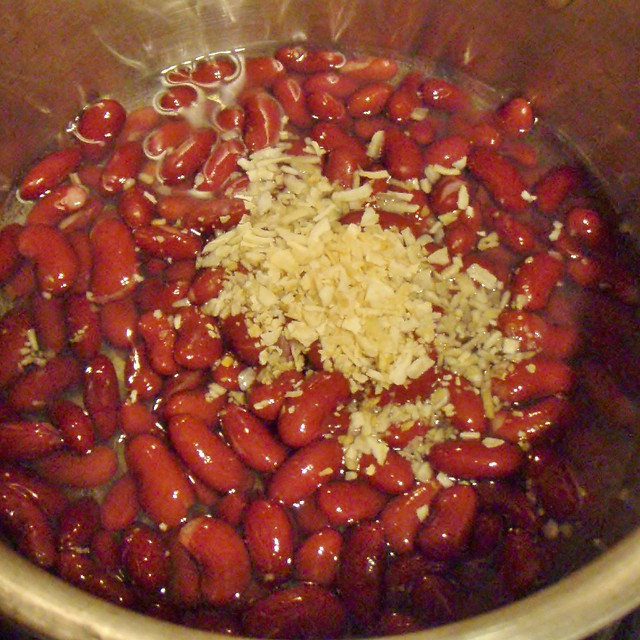 Drain and rinse the beans well, and then put them in a pot and just cover them with water. Add the onion flakes and bring to a boil.
Drain and rinse the beans well, and then put them in a pot and just cover them with water. Add the onion flakes and bring to a boil.
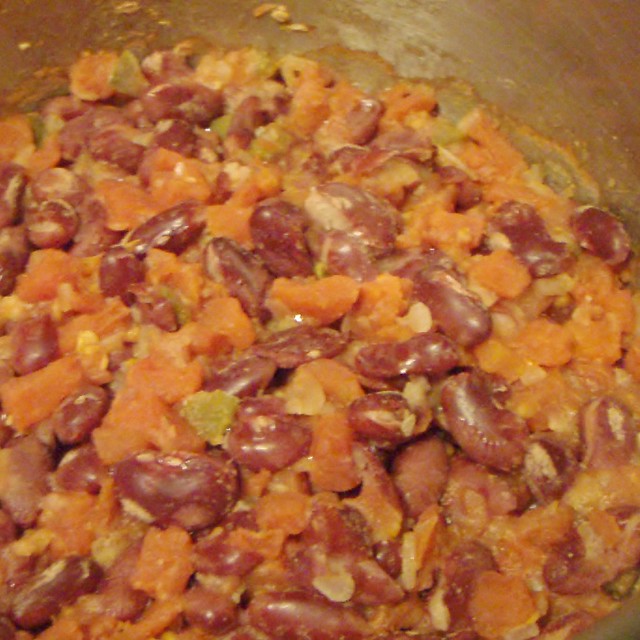 After about 5 minutes, add the can of tomatoes and continue boiling until the liquid is mostly gone and the beans are creamy, about 10 minutes. Add the coconut milk and boil until reduced by half and the juices form a thick, rich sauce, about 10 minutes more. Season to taste and serve over cooked rice. Nzuri!
After about 5 minutes, add the can of tomatoes and continue boiling until the liquid is mostly gone and the beans are creamy, about 10 minutes. Add the coconut milk and boil until reduced by half and the juices form a thick, rich sauce, about 10 minutes more. Season to taste and serve over cooked rice. Nzuri!
Other recipes for this dish indicate that it can be served as a soup, in which case I would add the tomatoes and coconut milk at the beginning, simmer just until the onions are rehydrated, and add water to thin as needed.
I can attest to the fact that this is a really easy recipe. No - I mean REALLY easy. The reason I can attest to this is that I managed to get this dish on the table despite fingers with 2nd-degree burns, an infestation of pantry moths, a mouse who left a wake of devastation in my kitchen last night culminating in the destruction of my pressure cooker, a last-minute, with-food-on-the-stove missing ingredient requiring a run to the store, and an understandably concerned and exasperated husband who had not planned to use his paramedic skills at home. Despite all of those things (none caused by the dish itself, mind you,) Penye niya, pana njiya, and we ate dinner as planned. The dish came out beautifully - I was amazed at how such simple flavors and textures work together like notes in a chord. So, if you're looking for an easy side dish - or a vegan main course - this is the one, baby! (Just make sure you actually have coconut milk, as opposed to thinking you have it.)
1 15-oz can dark red kidney beans
Water
1 tbsp dried onion flakes
1 10-oz can of diced tomato with green chili
1 5.6 oz can of coconut milk or 3/4 cup (do NOT use coconut cream or sweetened coconut milk)
Salt to taste
Cooked rice
 Drain and rinse the beans well, and then put them in a pot and just cover them with water. Add the onion flakes and bring to a boil.
Drain and rinse the beans well, and then put them in a pot and just cover them with water. Add the onion flakes and bring to a boil.  After about 5 minutes, add the can of tomatoes and continue boiling until the liquid is mostly gone and the beans are creamy, about 10 minutes. Add the coconut milk and boil until reduced by half and the juices form a thick, rich sauce, about 10 minutes more. Season to taste and serve over cooked rice. Nzuri!
After about 5 minutes, add the can of tomatoes and continue boiling until the liquid is mostly gone and the beans are creamy, about 10 minutes. Add the coconut milk and boil until reduced by half and the juices form a thick, rich sauce, about 10 minutes more. Season to taste and serve over cooked rice. Nzuri!Other recipes for this dish indicate that it can be served as a soup, in which case I would add the tomatoes and coconut milk at the beginning, simmer just until the onions are rehydrated, and add water to thin as needed.
Sunday, October 7, 2012
Sundays with Sparky: Bi Bim Bap (Korean Mixed-Up Rice, American Style)
Every culture has a dish that's all about digging into the bottom of your food stores and making do with what you have. Korea is no exception. I am guessing that bits of Banchan, the small vegetable dishes served with meals, must multiply in Korean fridges just like bits of produce does in mine. Enter Bi Bim Bap (Bap means rice, and Bi and Bim are both forms of the verb mix) - in America we might call it Everything But The Kitchen Sink Rice. Basically, leftovers are arranged on hot leftover rice (sometimes twice-cooked until it has a crispy bottom) with maybe a small portion of meat, the whole thing is topped with a lightly fried egg, seasoned with a chili-miso seasoning called gochujang, and vigorously mixed all together so the egg yolk and gochujang make a sauce. Mmmm.
Even though gochujang is less spicy than some chili pastes, it's a nonstarter for Sparky, so I usually sub hoisin (or doenjang, if I'm shopping at H-Mart) I also don't typically have any banchan in my fridge (I am the only person in my family who loves kimchi. Sniff.) so our version has become a clean-out-the-crisper-drawer thing. Most banchan is either pickled or cooked in some way, but instead we just put raw vegetables over the rice, although it's also a great way to get rid of leftover sauteed greens or the odd cooked green bean. In fact, saute up any greens that are still good but you wouldn't eat raw - salad greens work just as well as spinach. Don't worry about the details - the idea is to use whatever you've got.
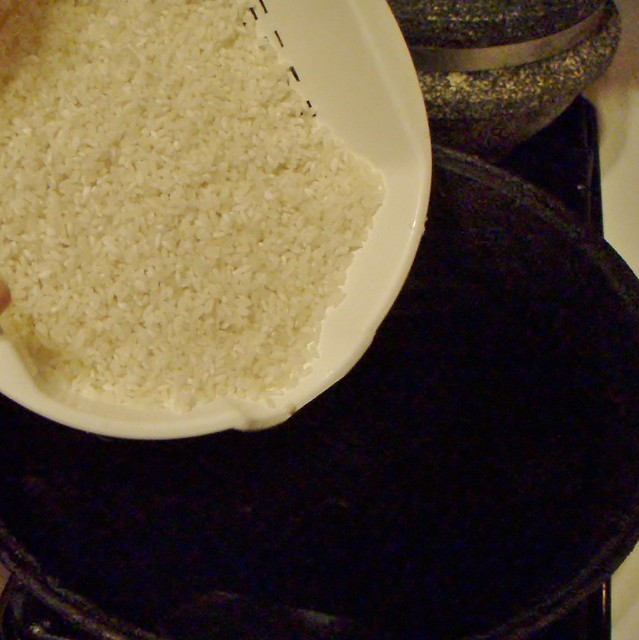 So, first, I started out doing the cooking parts of the dish: loosely following this recipe for sushi rice, I dumped well-rinsed and drained rice in my cast-iron skillet with water, tightly covered it, and brought it to a boil. I then turned it down to low, left it for 10 minutes, turned off the heat and let it sit for another 10 - amazing, perfect rice! I'm sold on this technique, so go to the terrific blog Just Hungry and check it out. If you use a nonstick skillet you will have to fuss with the temperature - but cast iron retains heat nicely.
So, first, I started out doing the cooking parts of the dish: loosely following this recipe for sushi rice, I dumped well-rinsed and drained rice in my cast-iron skillet with water, tightly covered it, and brought it to a boil. I then turned it down to low, left it for 10 minutes, turned off the heat and let it sit for another 10 - amazing, perfect rice! I'm sold on this technique, so go to the terrific blog Just Hungry and check it out. If you use a nonstick skillet you will have to fuss with the temperature - but cast iron retains heat nicely.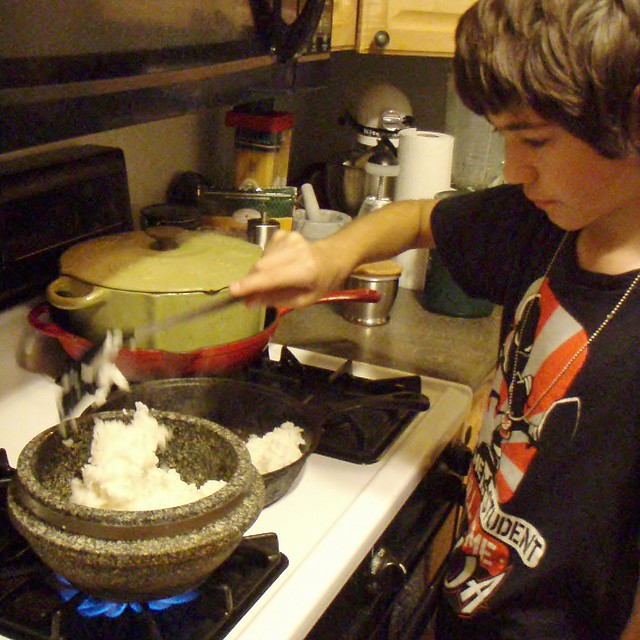 Then I had Sparky scoop the cooked rice into a hot Dolsot I had seasoned with some sesame oil. It's basically a pot made of pizza stone, and it gives the rice a lovely crispy-fried crust that is out of this world. An extra step, yes, but totally worth it. We covered the rice and left it on high to crisp up as we cut vegetables.
Then I had Sparky scoop the cooked rice into a hot Dolsot I had seasoned with some sesame oil. It's basically a pot made of pizza stone, and it gives the rice a lovely crispy-fried crust that is out of this world. An extra step, yes, but totally worth it. We covered the rice and left it on high to crisp up as we cut vegetables. Sparky did the heavy lifting: this dish is all about vegetable prep-work, making them small to mix easily into the rice. He sliced snowpeas, cut cucumbers into rounds, and peppers into strips.
Sparky did the heavy lifting: this dish is all about vegetable prep-work, making them small to mix easily into the rice. He sliced snowpeas, cut cucumbers into rounds, and peppers into strips.  He then used a vegetable peeler to make a huge pile of carrot shavings. (We also cheated and used a precut cole slaw mix.) The more veggies, the better.
He then used a vegetable peeler to make a huge pile of carrot shavings. (We also cheated and used a precut cole slaw mix.) The more veggies, the better. I browned some ground beef in a skillet, and splashed it with a bit of soy sauce and apple juice. As that was cooking, I put some sesame oil in my nonstick skillet and fried an egg for each person.
I browned some ground beef in a skillet, and splashed it with a bit of soy sauce and apple juice. As that was cooking, I put some sesame oil in my nonstick skillet and fried an egg for each person. Sparky mixed the crispy bits into the rice and scooped it onto large plates (Bi bim bap is usually served in large bowls; ours are just too small.) He then arranged all the vegetables and meat carefully over the rice, making a pattern where each topping had a colorful neighbor.
Sparky mixed the crispy bits into the rice and scooped it onto large plates (Bi bim bap is usually served in large bowls; ours are just too small.) He then arranged all the vegetables and meat carefully over the rice, making a pattern where each topping had a colorful neighbor. I slid a fried egg over the top of each serving and then decorated it with some hoisin - and we all dug in.
A delicious way to get your vegetables for the day! Enjoy!
Wednesday, October 3, 2012
Policy Point Wednesday - Panic at the Lunchroom
If you follow food news at all, I'm sure you've read about the conservative coalition moving to eliminate calorie caps in school lunches, or the school groups protesting what they call a one-size-fits-all approach. Previously, school lunches were governed by a mishmash of state policies that seemed more concerned with getting calories into children, whether they need them or not, than with teaching good eating habits. The current policy sets a cap of 850 calories per lunch for high school students - more than a typical fast-food lunch - and 650 for elementary school students; these limits represent 1/3 of the daily recommended calories for kids.
I am guessing that the problem is not really the calorie caps, but the types of foods that are now required by the new legislation. New school lunches have a focus on fruits and vegetables , and contain fewer calories from "kid-friendly" foods like pizza, french fries, and nachos. "Kid" foods haven't disappeared from school lunch - they are just offered in smaller portions, with a larger proportion of the calories coming from foods like sweet potatoes, re-fried beans, steamed vegetables, salads, and fruit. The real problem with the new school lunch is that many kids suffer from food neophobia, and just aren't used to these items which comprise (per guidelines from the Institute of Medicine) a large proportion of the calories for the meal.
In 2010, Agriculture Secretary Tom Vilsack, as part of an announcement about the USDA's Fresh Fruit and Vegetable Program, said "Improving the health and nutrition of our kids is a national imperative and by providing schools with fresh fruits and vegetables that expand their healthy options, we are helping our kids to have a brighter, healthier future," ... "Every time our kids eat a piece of fruit or a vegetable, they are learning healthy eating habits that can last a lifetime."
Neophobia of foods is not uncommon with children, and it can be difficult to address - but our current system of pandering to children's tastes just to get food in them sets up a lifetime of unhealthy behavior. Children learn to eat new foods by repeated, positive exposures - and the school lunch system now offers consistent exposure to a variety of healthy foods. Offering good, healthy food is the adult's responsibility. Choosing to eat it or not and learning the consequences of that choice is the kids' responsibility.
Creating healthy eating habits is critical to improving nutrition and reducing diet-related disease in our most vulnerable populations. Detractors of the new lunches insist that every child should have access to all the calories they want to ensure that the kids who depend on school lunch get what they need. Rather than taking this blanket, not to mention expensive, approach, I think schools and communities should work to identify families in need and connect them to the wide variety of programs available to ensure their children get three meals a day: SNAP, WIC, School breakfast, Afterschool Snacks, and the Seamless Summer Option, in addition to local community resources like food pantries and soup kitchens. Kids need to eat, but more importantly, they need to learn to eat well.
I am guessing that the problem is not really the calorie caps, but the types of foods that are now required by the new legislation. New school lunches have a focus on fruits and vegetables , and contain fewer calories from "kid-friendly" foods like pizza, french fries, and nachos. "Kid" foods haven't disappeared from school lunch - they are just offered in smaller portions, with a larger proportion of the calories coming from foods like sweet potatoes, re-fried beans, steamed vegetables, salads, and fruit. The real problem with the new school lunch is that many kids suffer from food neophobia, and just aren't used to these items which comprise (per guidelines from the Institute of Medicine) a large proportion of the calories for the meal.
In 2010, Agriculture Secretary Tom Vilsack, as part of an announcement about the USDA's Fresh Fruit and Vegetable Program, said "Improving the health and nutrition of our kids is a national imperative and by providing schools with fresh fruits and vegetables that expand their healthy options, we are helping our kids to have a brighter, healthier future," ... "Every time our kids eat a piece of fruit or a vegetable, they are learning healthy eating habits that can last a lifetime."
Neophobia of foods is not uncommon with children, and it can be difficult to address - but our current system of pandering to children's tastes just to get food in them sets up a lifetime of unhealthy behavior. Children learn to eat new foods by repeated, positive exposures - and the school lunch system now offers consistent exposure to a variety of healthy foods. Offering good, healthy food is the adult's responsibility. Choosing to eat it or not and learning the consequences of that choice is the kids' responsibility.
Creating healthy eating habits is critical to improving nutrition and reducing diet-related disease in our most vulnerable populations. Detractors of the new lunches insist that every child should have access to all the calories they want to ensure that the kids who depend on school lunch get what they need. Rather than taking this blanket, not to mention expensive, approach, I think schools and communities should work to identify families in need and connect them to the wide variety of programs available to ensure their children get three meals a day: SNAP, WIC, School breakfast, Afterschool Snacks, and the Seamless Summer Option, in addition to local community resources like food pantries and soup kitchens. Kids need to eat, but more importantly, they need to learn to eat well.
Subscribe to:
Posts (Atom)


